2
Krista Galyen
Leah Chuchran-Davis
Mary Helen Culbertson
Introduction
“Engineering is figuring out how to do what you want with what you’ve actually got.”
—John Carmack (2019)
John Carmack, a well-known engineer and video game programmer, stated that engineering was ultimately “figuring out how to do what you want with what you’ve actually got.” Instructional design and engineering have much in common when it comes to ways of thinking. They both involve encountering a series of design problems, and the way we think about and approach these problems is foundational in achieving exceptionality. Exceptional instructional design is ultimately grounded in a thorough and rich understanding of human learning and approached with sensitivity to and a deep understanding of context (e.g., humans, environments, tools, tasks). The instructional designer need not be focused on applying rigid “rules,” but instead should focus on how to think like an instructional designer while solving design problems. In the spirit of John Carmack’s quote, an instructional designer is, in essence, a type of educational engineer. This chapter, rather than merely walking through the aspects or outputs of quality instructional design, outlines how quality instructional design can be achieved by everyone, using six fundamental mindsets and approaches.
Fundamental 1: Make Design Decisions Using Three Lenses of Learning Innovation
Instructional designers blend foundational education theory, models, and frameworks with the reality and nuances of context to support optimal learning outcomes. Excellence emerges from well-applied theory and frameworks. A good way to represent this blending of theoretical conception and contextual application (how instructional designers make good design decisions) is through the “Three Lenses of Innovation” (Kelley & Kelley, 2013, p. 19) and what IDEO describes as “the intersection of design thinking.” This model is altered here (see Figure 1) to focus on learners, and by exchanging “desirability” for “learner-centered” (effective, pleasurable, meaningful experiences). There are three key lenses for great instructional design that also guide learning-design thinking and decision-making:
- Learner-centered: Focused on effective, pleasurable, and meaningful experiences for the learner;
- Feasible: Can be accomplished;
- Sustainable: Easy to maintain, support, and grow over time.
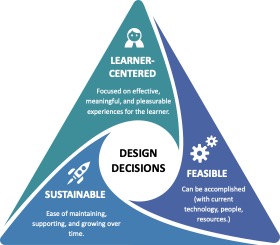
Figure 1. Three lenses of learning innovation for instructional design, modified from The Three Lenses of Innovation (Kelley & Kelley, 2013).
Learner-Centered
To be learner-centered is to design while focusing on fulfilling the learner’s needs and desired outcomes. In Seductive Interaction Design (2011), Stephen Anderson describes the “Learner Hierarchy of Needs” (see Figure 2). As in Maslow’s hierarchy of needs (1943, 1954), the base of the pyramid is essential and must be present to successfully support the next level. Once an individual fulfills one level, they look to the next level of fulfillment. For example, in the Learner Hierarchy of Needs, learners need to log in (functional), but they also need the site to have excellent uptime (reliable). When designing for learning, many may stop at “convenient”—meaning that students can log in reliably, they can use the course without difficulty, they can find what they need, and they know where to submit assignments. Students can even use the course across multiple devices and access it anytime, anywhere: it is convenient for their lifestyle. Indeed, these are all important and fundamental aspects of excellent, learner-centered experiences.
But the pleasurable, meaningful experiences represented by the top two levels of the hierarchy are where real transformation in identity and outcome occur. Exceptional instructional design never stops at convenience; it continuously strives toward pleasurable, meaningful learning.
To achieve exceptionality in design, designers must push for all levels of the learner hierarchy of needs to be met, stretching toward designing for those top tiers of the pyramid when creating assessments and activities, and tailoring the structure for effectiveness. It is in striving for effectiveness (the ability to achieve learning outcomes) that designers draw upon theory and understanding of human learning, motivation, and key principles of instructional design.
For learning design to be effective, there must be solid instruction, activities and opportunities for specific feedback, valid assessments, and clear objectives and outcomes, with strong alignment among them all. To be meaningful, the learning design should be relevant, authentic, and connected to students’ lives (which requires designers to know who learners are). To be pleasurable, the experience should lead learners to experience moments of pride, joy, or connectedness (to name a few positive results). All of these aspects of effectiveness require empathy with regard to learners, where they are, and where we want them to be. Most instructional design work resides in the “learner-centered” lens, but it should not stop there. To be exceptional, the second and third lenses must also be employed in practice.
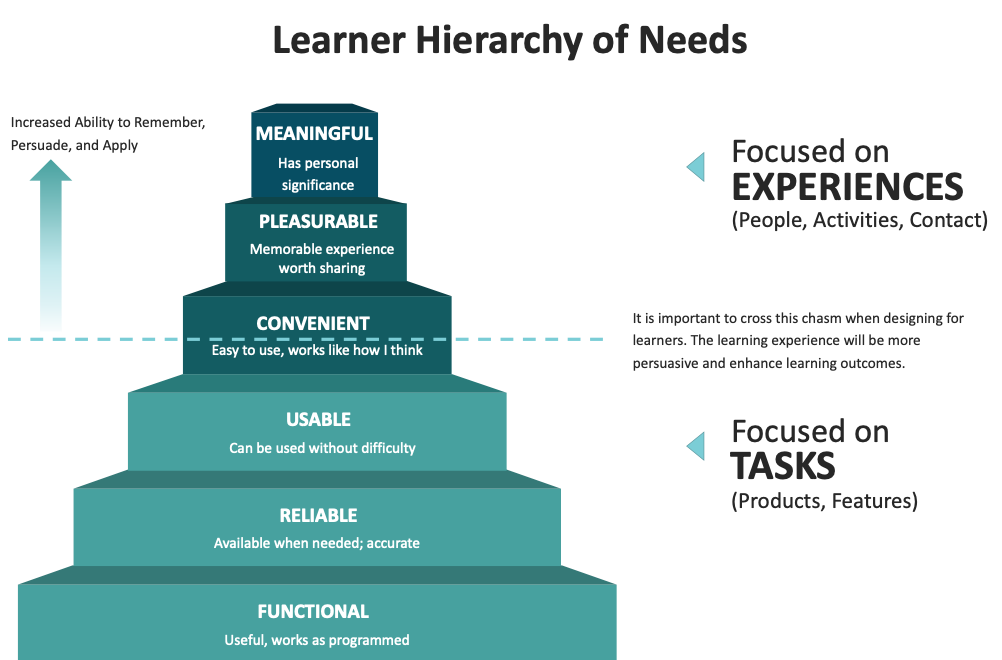
Figure 2. Modified learner hierarchy of needs (based on Anderson, 2011, p. 12).
Feasible
What designers conceptualize should be possible. This second lens of feasibility also means that when innovating, new ideas should not be discarded simply because they have yet to be tried. If the innovation is learner-centered and grounded in how people learn, and if the idea is feasible to accomplish given the context, it can be implemented and tested through a design thinking process.
Sustainable
Just because you can, doesn’t mean you should. In other words, just because something is feasible, that doesn’t mean it is sustainable. Ideas can be learner-centered and feasible, but if an idea or design is not sustainable over time, it likely is not the best choice for learners or those responsible for facilitating it. Determining sustainability requires a deep understanding of and sensitivity toward context. For example, in one instance a group of instructional technologists may not have the capacity to edit and maintain certain types of interactives, whereas other groups may have expertise, funding, and capacity. Each situation requires a consideration of context when making design decisions, as decisions made now have both positive and negative ramifications over time.
Fundamental 2: Use Design Thinking as the “Way of Thinking”
“Design thinking taps into capacities we all have but that are overlooked by more conventional problem-solving practices. It is not only human-centered; it is deeply human in and of itself. Design thinking relies on our ability to be intuitive, to recognize patterns, to construct ideas that have emotional meaning as well as functionality, to express ourselves in media other than words or symbols.”
—Tim Brown, Change by Design (2009)
Design thinking, a term coined by John Arnold in Creative Engineering in 1959 (see Arnold, 2016), was first discussed as a “way of thinking” and approaching design problems, and the term was expounded upon in Herbert A. Simon’s 1969 book The Sciences of the Artificial. Since then, the concept has evolved as it has been applied to a wide array of fields from the sciences to education to the arts. The Interaction Design Foundation (2019) describes design thinking as a nonlinear process of solving design problems through five key, iterative phases (see Figure 3): empathize, define, ideate, prototype, and test.
To think like a designer, one must empathize with learners; this enables the designer to clarify and define the design problem. To empathize with a learner means to understand and feel (as much as possible) what it is like to be that learner. For example, perhaps a particular nursing course has several discussion boards that require students to post six times in a week. The designer thinks through the life, environment, and prior experience of the typical student in this course, and realizes students are working 12- and sometimes 24-hour shifts, and they are often working adults with families. They frequently use mobile phones to access the course, engage with the course during breaks, and often may be away from the online course for an entire day, depending on their workload that day or that week. For half the students, this is their first online course, whereas for the other half, online courses are familiar. Because the students are working nurses, they bring a great deal of experience and background, and want to be treated like knowledgeable professionals, not new students.
By thinking through a typical scenario, the designer gains empathy for the learner, which in turn reveals the problems and helps to shape the design solutions that support the students. Defining the problem allows the designer to generate design ideas and learning solutions, prototype them, and test them. This testing generates more questions or reveals additional problems, as well as refining ideas about how to design.
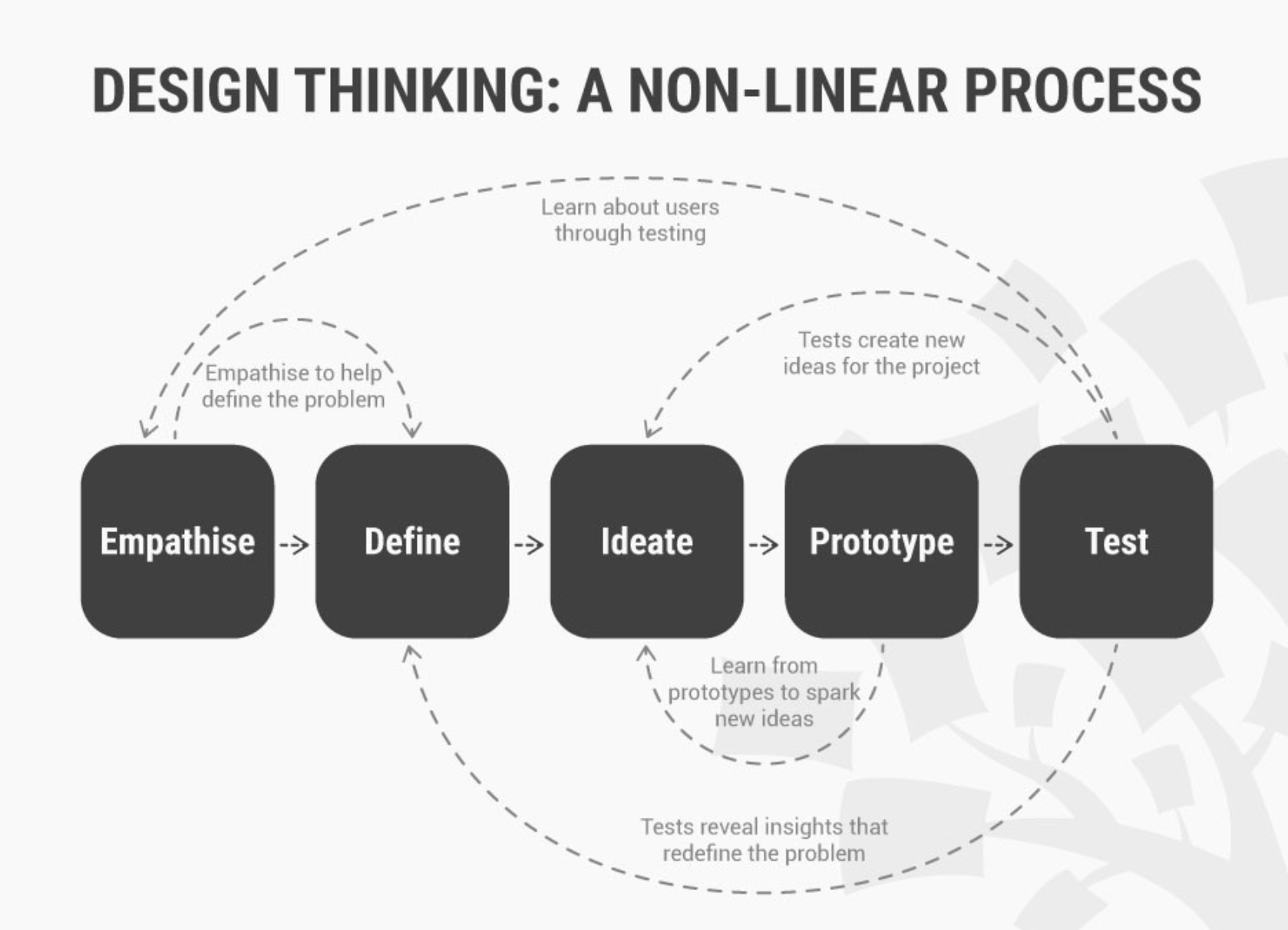
Figure 3. One example of design thinking as applied in the interaction design field. From Interaction Design Foundation (CC BY-NC-SA 3.0, by Teo Yu Siang).
In the EdSurge article “UX to LX, The Rise of Learner Experience Design” (2016), Kilgore represented design thinking through the learner experience design lens. This model (Figure 4) closely aligns with how designers approach the application of design thinking in instructional design. While this model is also nonlinear (hence the dotted lines indicating returning to iterate), there are phases in the design process where different aspects of design thinking are emphasized, and discrete stages occur. For example, when beginning a course development project, it is important to engage heavily in the “discovery” phase that involves learning about the learners, empathizing, and “mind-melding” with the subject matter experts (SMEs) to (iteratively) clarify the design problem and goals.
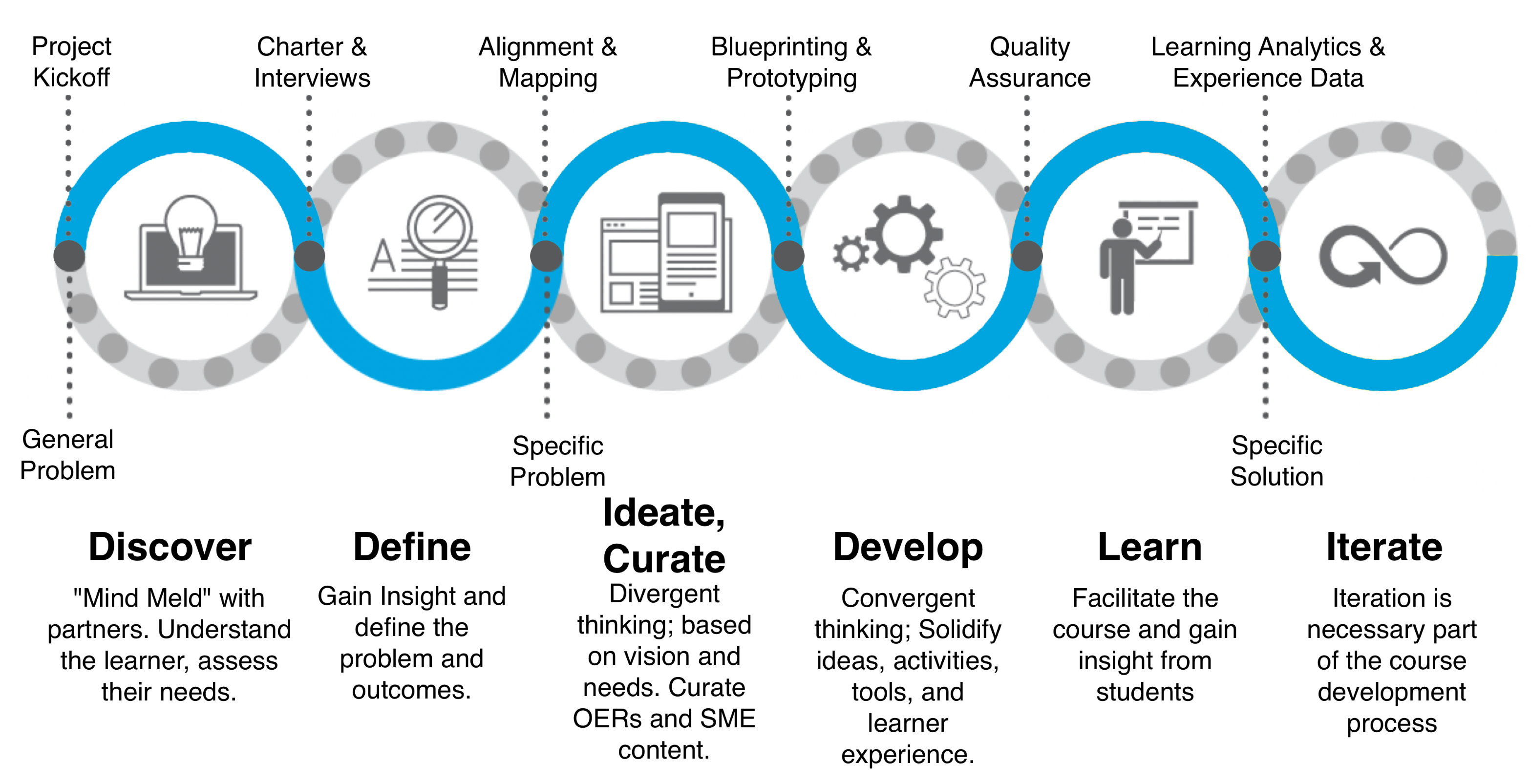
Figure 4. Design thinking in instructional design – empathize, define, ideate and curate, develop, learn, and iterate (modified from Kilgore, 2016). The dark gray dots indicate frequent design events that can occur at the iterative intersections of design thinking processes.
Instructional Design Models to Support Ways of Thinking
Over the last century, learning design models have transformed the way that curriculum development is approached. Some of the most popular are the Successive Approximation Model or SAM (Allen, 2002), Attention, Relevance, Confidence, Satisfaction or ARCS (Keller, 2010), Gagné’s nine events (Gagné, 1965), backward design (Wiggins & McTighe, 2011), and Merrill’s First Principles of Instruction (Merrill, 2002).
ADDIE (Analysis, Design, Development, Implementation, and Evaluation)
Likely the most “famous” such model is ADDIE, which is also known historically as instructional system design or ISD (Clark, 2015; Dick, Carey, & Carey, 2014). It is widely used and referred to because it is broad in scope and user-friendly, and can be used iteratively through different phases of design and development projects. This model can be applied to education, training, corporate, and other types of projects.
ADDIE represents five common stages of design and development (Figure 5): analysis, design, development, implementation, and evaluation. Analysis is the needs assessment and gap analysis. Design is the ideation of a solution to those learning and performance gaps. Development is the concretization of those ideas, often in the form of a written curriculum, learning management system (LMS) design, or interactive module. Implementation is the use of the developed learning object or designed experience with actual learners. Evaluation occurs throughout the process, in terms of both formative evaluation (identifying gaps to make things better along the way) and summative evaluation (how and to what degree the intervention was able to create the intended outcomes.)
One of the criticisms of ADDIE is that it was developed as a linear (“waterfall”) model, meaning that each stage should be finished and then feed into the next. However, the use of evaluation throughout all stages makes the model slightly iterative by nature. Over time, many have molded the model to work with more nonlinear approaches in order to better apply design thinking to instructional design. (In fact, one might notice some similarities between design thinking and the ADDIE model!)
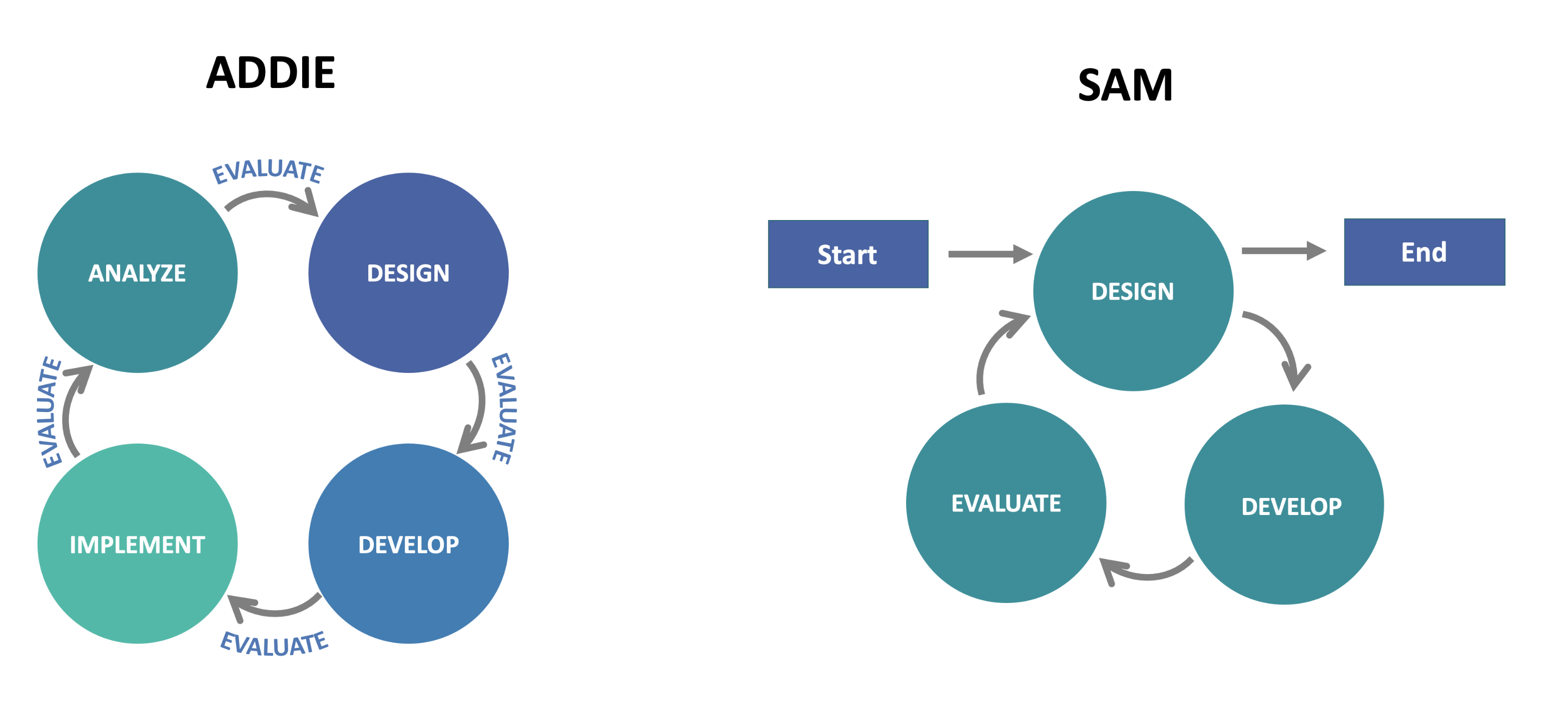
Figure 5. Instructional systems design models: ADDIE (left) and SAM (right).
Successive Approximation Model
The successive approximation model (SAM; Allen, 2012) is a nonlinear, agile approach to instructional design. By defining the need and understanding the learner, and through ideation and testing, designers can make successive approximations toward an optimal learning experience. (Figure 5)
Backward Design
In backward design (Wiggins & McTighe, 2011), the final assessment is considered first. Learning objectives are written and, in many cases, the assessment is created before any content or activities are added to the plan. In this way, students are more likely to successfully meet the goal of the course, as long as everything aligns with the objectives.
While there are additional models and approaches, ultimately each designer should find a model and approach that fits their goals, purposes, and context. There may be times when a linear approach is best (e.g., the problem is well defined or well structured; the solution and processes are known and work well). Other times, a nonlinear approach is best (e.g., the problem is ill-defined or ill-structured, the solution and processes are not known or well understood, or there is a need to be open to new ideas and approaches). No matter the model, design thinking is the foundation needed for creative innovation in design to flourish.
Fundamental 3: Strive for Deep Empathy and Understanding to Accurately Discover and Define Context, Problems, and Goals
Who are you, where are you, where do you want to be,
and why is it important to you?
Education is a type of transformation. If a learner is not changing in some way, at some level, then learning is not occurring. Luckily, humans learn innately. Every interaction, conversation, and reading changes us in small ways. If students engage in a course where the instructor never shows up to class on time, they learn that they are not important. If they engage in a course where the instructor gives rich feedback and encourages students personally, they learn that they are important. Instructional design is not merely about whether designers and instructors can help students learn in general, but rather about how they can support learners to transform toward highly specific and well-defined outcomes, and how those outcomes and transformations can be measured. Instructional design expertise resides in knowing how to facilitate this type of clearly defined transformation for diverse learners in, typically, a remote or blended learning environment.
Education is also a type of intervention. An intervention is something that intervenes to achieve a desired outcome that could not be achieved without this help. The intervention changes the normal trajectory or pattern of behavior or learning.
The fundamental role of the instructional designer is to help design experiences that create a meaningful, pleasurable intervention where the learner is transformed toward the desired outcomes. To do this, designers must discover who the learners are, where they are (in their learning and lives), where they (and the SME and program) want them to be, how to help them arrive there, and why anyone (especially the learner) should care about any of it at all. The process of uncovering this overarching contextual information is called “discovery.” The identification of the gap (between where the learner is and where we want them to be) is the “defining” of the problem.
Discovery Through Charters and Interviews
Ideal approaches to discovery engage the use of interviews and agile project (or team) charters. These strategies help designers to understand the learners and where they come from, and to gain insight into who they are and the context in which they live, work, and learn. Just as one cannot head in the right direction without knowing one’s destination, designers cannot make the right design decisions without knowing who they are designing for and why.
Project or Team Charters
Project or team charters have their origin in agile methodologies, which arose as a pushback against waterfall techniques where an a priori design drove the development process (rather than the human-centered problem driving the development process forward to a human-centered solution.)
“There’s really just one thing that matters in creating an agile team charter: anchoring to a problem instead of a solution . . .. Because problems, defined correctly, are durable and keep you focused on what’s valuable . . ..”
—Alexander Cowan, “Agile Team Charters, The Basics”
Charters help designers establish the why behind the design, what the problems are, who they are designing for, the teamwork expectations, and the drivers. Typically lasting just a session or two, charters provide the team of instructional designers, technologists, SMEs, and other stakeholders with a shared understanding of their mission, the key issues, and reasons why the goals are important ones to achieve.
Interviews
Interviews are important components of project charters and are also an excellent tool to use when working with SMEs on course designs. The purpose is the same, but at a more granular, course-specific level. Interviews help SMEs answer the questions “Who are you? Where do students typically start? Where do you want students to go? Why is your topic important?” Instructional designers listen to these answers and, through this discovery process, begin to arrive at the how. When initially working with SMEs, designers must listen and question. (It is the discovery phase, not the tell them everything you know phase!) Ask big, overarching, open-ended questions that lead the SME to begin telling the story of their course. Encourage SMEs to not filter out ideas because they think they cannot be done; encourage big, exploratory thinking and questions at this stage. The first interview is a great place to get SMEs to open up, which allows opportunities to listen and inquire. It is a time to take plenty of notes; these interviews can be a treasure trove of ideas during the ideation stage for authentic projects and activities.
Discovery Through Learner Empathy Mapping and Personas
While project charters and interviews are a great start for understanding learners and their contexts, ultimately an instructional designer needs to deeply understand and empathize with the learner in order to do great design.
Empathy Mapping
One of the primary aspects of the discovery stage in design thinking is empathy mapping (Gibbons, 2018). Figure 6 shows a common structure for a learner-aggregated empathy map, and Figure 7 shows a sample of a completed learner empathy map for prospective students in a nursing course.
Information for empathy maps can be gleaned from interviews with learners, program administrators, SMEs, and instructors, among other stakeholders. Learner empathy mapping also serves as a form of needs assessment during this discovery phase. The sample aggregated learner empathy map demonstrates that some students may be new to online learning, that they are all working adults with a great deal of experience, and that they care deeply about helping others. These facts help to shape the decisions designers make about the optimal design for these learners.
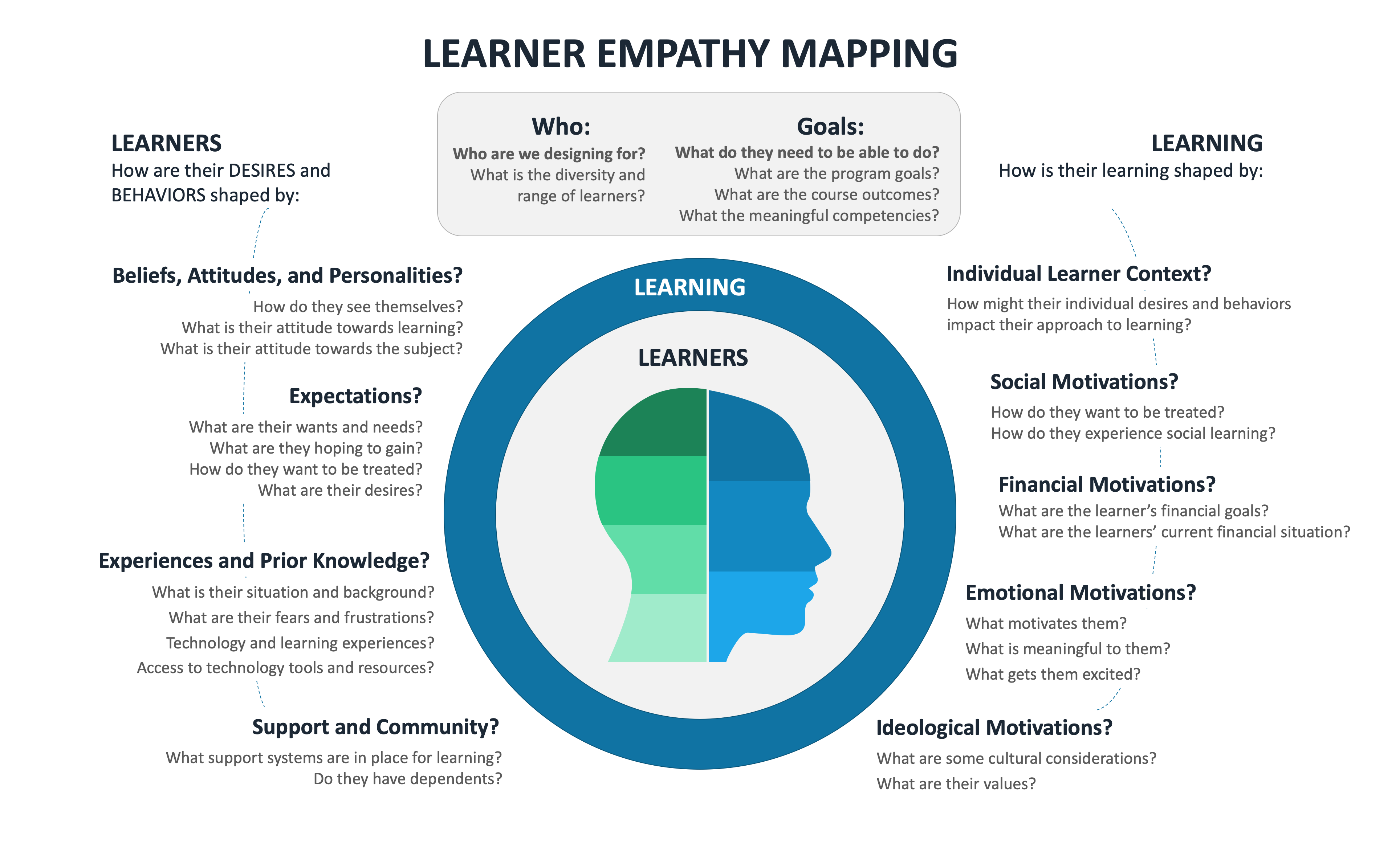
Figure 6: Learner empathy mapping structure.
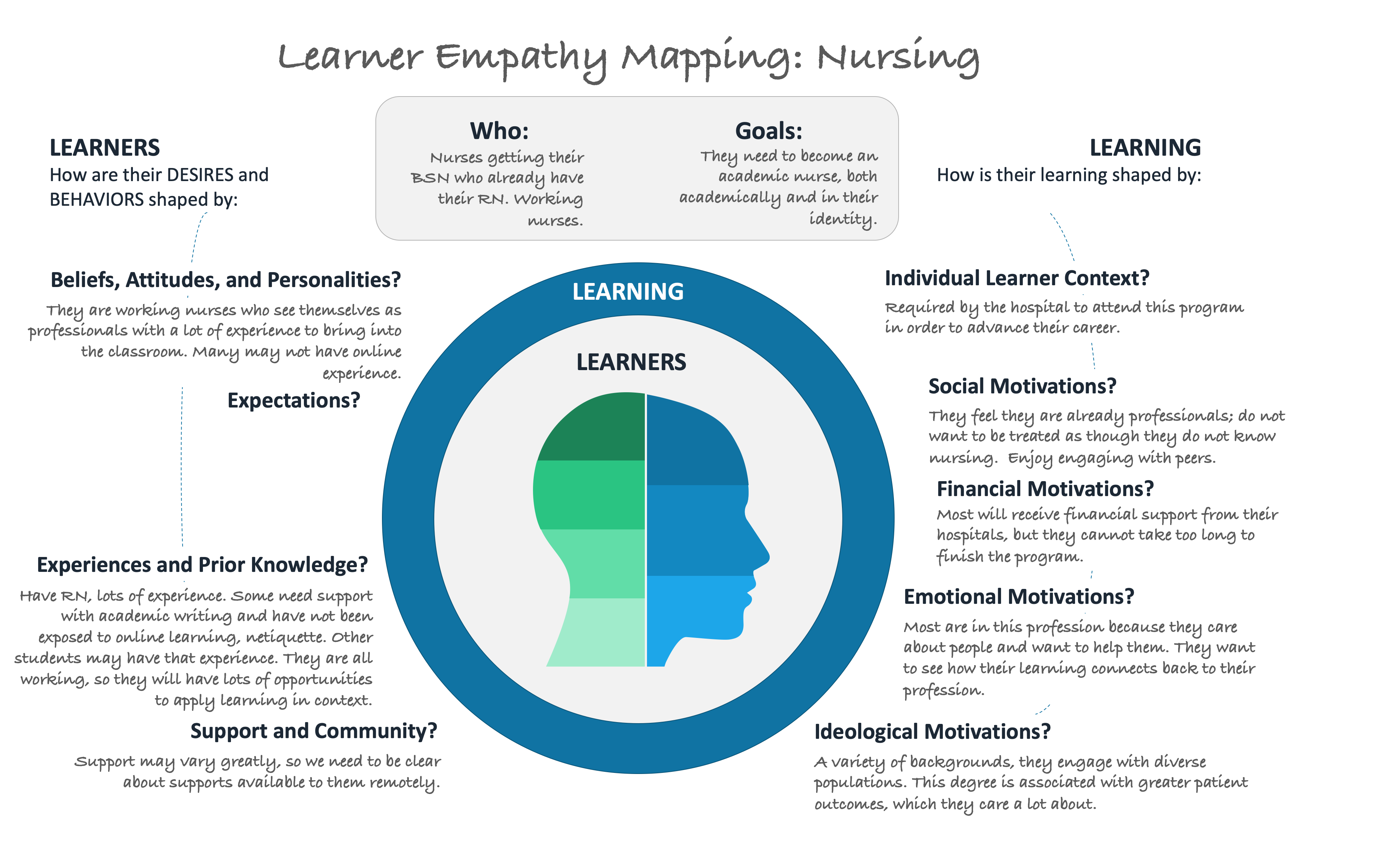
Figure 7: Sample aggregated learner empathy map for prospective learners in a nursing course.
Learner Personas
Empathy maps can be used to create learner personas. Learner personas are essentially learner archetypes that help designers crystallize the abstract and humanize what they’ve gleaned about the learners into a visual and narrative form. Indeed, it is another form of focusing on the problem rather than on an already identified solution; by keeping the learner front and center, designers are humanizing the design problem. In short, instructional designers help to create experiences for real people with actual needs in the hopes that they can achieve their goals. Figure 8 shows a sample learner persona developed for the nursing program, based on prior empathy mapping. In leading the team, instructional designers should continually return to the personas as the team ideates and thinks through design decisions.

Figure 8: A sample learner persona for a nursing program.
Defining the Problem Through Alignment and Mapping
Alignment
Instructional design is intentional and experiential. The outcomes of learning and curriculum design must be determined in the same way to support institutional and programmatic requirements. Yet alignment is also necessary for accreditation purposes, which has become increasingly important for online programs. Alignment ultimately means taking a human-centered approach and creating meaningful and applicable formative and summative assessments and activities to support and measure learning, often by creating a high-level alignment map to key desired outcomes (see an example in Table 1.) Alignment also means tracking and ensuring that problems are kept front and center in the design solution, in the following ways:
- By teaching the content that students need to learn (instruction, content);
- Allowing students to practice the skills and knowledge needed to perform (formative assessment);
- Making sure the students learn the content and can apply it in context (summative assessment, authentic summative assessment);
- Supporting students in an effective and rigorous yet efficient education;
- Ensuring an intervention that is designed toward the appropriate goals and needs.
Alignment often happens at multiple levels:
- How are the course learning outcomes aligned to the program learning outcomes, professional standards, and institutional learning outcomes?
- How are all the activities and assessments in the course aligned to the course learning outcomes?
Sample Alignment Table
| Course learning outcomes (CLOs) | Program learning outcomes (PLOs) | Professional standards 1 | Professional standards 2 | Institutional learning outcomes (ILOs) |
| Critique and present analysis in a setting with authentic features | 2, 5 | II, III, IV | 1 | 2, 3 |
Table 1. Sample alignment of course learning outcomes, program learning outcomes, professional standards, and institutional learning outcomes (ILOs).
Sample high-level map of one course learning objective
| Course learning objectives
(What do you want learners to do?) |
Enabling learning objectives
(What is the path to the CLOs?) |
Learning materials
(How will you teach the learners? What will you need?) |
Learning activities
(How will learners practice?) |
Assessments
(How do you know learners have met the objectives?) |
| Critique and present analysis in a setting with authentic features | Identify and define key terms
Describe and discuss key concepts
Apply concepts in case scenarios
Propose an original use of key concepts
Critique proposed use of key concepts |
Read text
Watch video
View lecture |
Review a scenario
Whole-group discussion
Small-group case study activity
A written proposal or presentation (team or individual)
Peer review of proposal or presentation, with notes for improvement |
Knowledge checks (formative)
Comments (formative)
Worksheet (formative)
Paper or presentation (summative)
Peer review comments (formative) |
Table 2. Sample high-level map of one course learning objective (CLO) demonstrating alignment (from the iDEA Book: iDesignEDU, 2019).
Mapping
A course map (as demonstrated in Table 2) is a high-level view of the learner experience. It showcases the alignment but can also show and highlight the curricular flow and rhythm from module to module. Mapping moves away from discovery and iterates back and forth between divergent ideation and convergent mapping (e.g., defining and describing the assessments and activities). To have a well-structured course, not just a well-aligned course, human learning theory and instructional frameworks should be used to guide the scaffolding, flow, and design decisions. This brings the topic back to the three lenses of innovation.
Objectives
Objectives are the driving force in designing learning, as they describe what learners should be able to demonstrate after a learning experience. They should be meaningful, measurable, and specific. Many designers use learning taxonomies, such as the revised Bloom’s taxonomy, to provide a framework when writing learning objectives. Other taxonomies include Miller’s pyramid of clinical competence (Miller, 1990), Webb’s depth of knowledge (Webb, 2002), and the Structure of the Observed Learning Outcome (SOLO) taxonomy (Biggs & Collis, 2014).
Assessments
Assessments are the visible manifestations that allow instructors to measure and evaluate learning. Quality assessments should be meaningful, authentic, valid (actually measuring what they are intended to measure), reliable, and aligned to outcomes, and should have clearly communicated success and grading requirements. Assessments can be either formative and lower stakes (used to inform how to improve) or summative (used to evaluate the degree of success in achieving the stated objectives).
Fundamental 4: Establish the Flow Through Vision, Narrative, and Frameworks
“The best courses tell a story, inviting students on an engaging and challenging journey.”
—The iDEA Book (iDesignEDU, 2019)
The Relationship between Structure, Narrative, and Vision
Just as alignment and mapping provide the internal structure, like a skeleton, narrative and vision are the connective tissue that unifies the design and experience. Humans learn through stories, and each learning experience should be thought of as a longer, overarching story or narrative experience. This idea of the story is the narrative, and the intention behind the rhythm, flow, look, feel, and experience is the vision. These will serve as guideposts to ensure a pleasurable, meaningful experience. To define a vision, an instructional designer will engage in cycles of divergent and convergent ideation (see Figure 9).
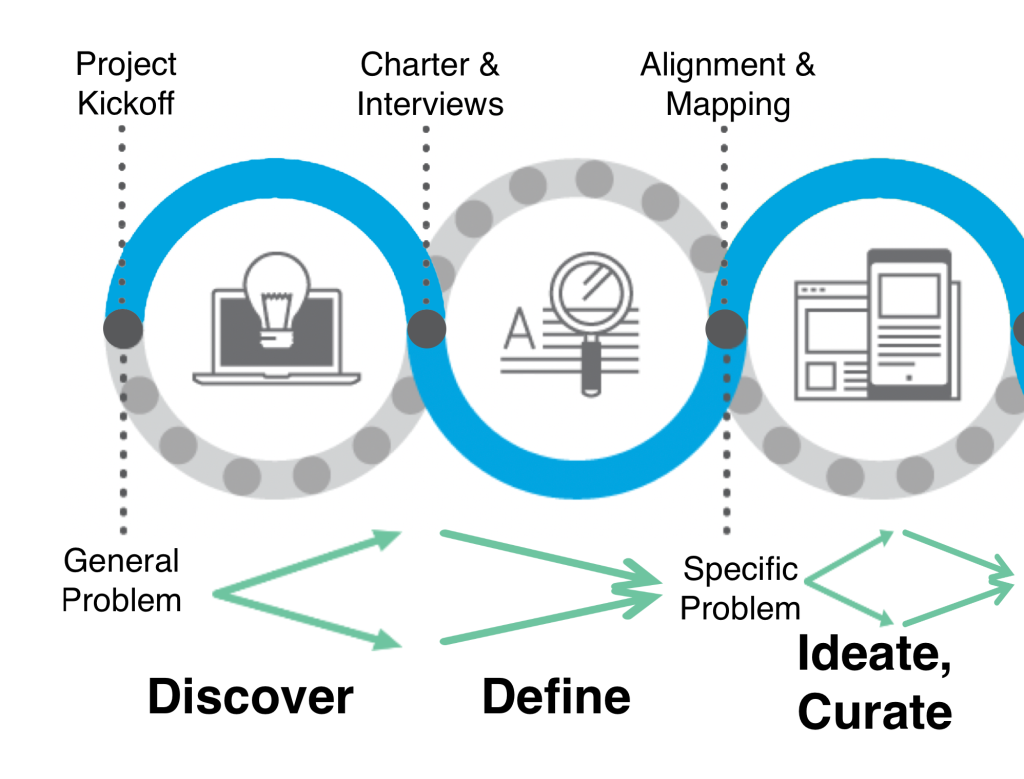
Figure 9. Discovery and defining are iterative; discovery requires divergent thinking while defining requires convergent thinking to define the design problem.
Narrative
A quality narrative is engaging, meaningful, and authentic, and puts the learner in the center of the problems. Quality narratives also are a natural fit with the content, learning objectives, and outcomes. It is not always easy to create a quality narrative, and doing so often requires conversation and collaboration within a team.
Vision
A vision provides direction in the mapping and ideation steps by:
- Defining the learning problem;
- Providing potential instructional frameworks that can be explored based on the defined problem and narrative;
- Providing a mission and overarching direction for the design problem based on the three lenses of innovation;
- Creating visual examples of what the learning experience could look like in the end (more ideation time may be needed for this).
Learning Theories
Learning theories are evidence-based models that attempt to explain, model, and predict how people learn. (It is important to note that different learning theories may also operationalize learning differently from one another.) There are many learning theories; three overarching learning theory paradigms will be reviewed here.
Behaviorism pays attention to behaviors (rather than what is going on in the mind) and focuses on conditioning, stimuli, and responses. Cognitivism pays special attention to a person’s mind (in particular, their very human and biological strengths and weaknesses) and uses that knowledge—such as memory abilities, when learners might get overwhelmed (cognitive load), and humans’ innate need for social interactions (social learning theory)—to inform learning design. Constructivism acknowledges that learners can be supported to construct their own knowledge through solving problems (problem-based learning) or exploring cases (case-based learning). Social constructivism is focused on scaffolding within a learner’s zone of proximal development (Vygotsky, 1978). For instructional designers, it is the source of much analysis of learners, contexts, and the design of pacing and sequence. A designer will look to these key paradigms to inform the learner-centered vision and narrative, which then helps clarify the assessments, assignments, and activities.
Learning Frameworks and Instructional Strategies
A learning (or instructional) framework is a system of related theories, concepts, and approaches that drives methods of designing instruction and teaching people. Frameworks are rooted in particular learning and teaching paradigms, include one or more learning theories, and often have affordances and weaknesses in different situations, contexts, and purposes.
For example, problem-based learning (PBL) is often utilized in medical education. PBL is well suited for ill-structured problems, case studies, and nonlinear learning without extensive scaffolding. On the other hand, direct instruction is often employed in mathematics education, where it is well suited for well-structured problems, worked examples, modeling, feedback, and systematic scaffolding. This is not to say that medical education does not engage in direct instruction, and of course mathematics education can also engage in problem-based learning. However, there often is a “learning recipe” of frameworks that an instructional designer will choose to guide the vision and narrative of the course.
The period after the interviews, charter, and alignment is a prime opportunity for the designer to establish the beginning of a vision and narrative. Instructional designers should draw upon their knowledge of frameworks and theories to support student outcomes given the content domain, goals, and contextual factors. There are many great learning strategies for designing exceptional experiences. But some learning strategy must undergird each experience.
Quality Review: Obtaining Feedback Early and Often
Getting feedback, early and often, is a core principle of an agile approach that dovetails perfectly with instructional design, design thinking, and quality review. As the alignment and mapping phases end, this is the ideal time for an initial quality review. The aim of performing an initial quality review at this stage comes from principles of agile and rapid prototyping: (1) fail fast (in other words, take action and get feedback quickly in order to iterate); and (2) fail often (in other words, leave room for multiple iterations—don’t allow only one shot to get things right). Instructional designers must remember that perfection is the enemy of progress. This means that if designers seek perfection in one shot, they will not make great strides in their designs. Designers must give themselves the opportunity and time to fail, try out new ideas through iterations (a central component of design thinking), and let the lenses of innovation guide their decision-making; doing so will lead to amazing progress in their designs.
The end of the alignment and mapping stage is a key flex point before a significant amount of energy is poured into the details of the course in the blueprinting and prototyping stages. Getting feedback for further refinement and confirmation of quality on the course alignment and map can help course-correct a particular design trajectory that may be off or missing important elements.
OSCQR and QM Rubrics
Two well-known tools for quality review are the Open SUNY Course Quality Review (OSCQR) Rubric and the Quality Matters (QM) Rubric. While the OSCQR Rubric leans toward a focus on nonevaluative feedback for continuous improvement, and the QM Rubric has an evaluative nature, both support the review of key quality indicators of course design, such as learner centeredness, alignment, assessments and measurement, design and layout, content and activities, interaction, feedback, and accessibility.
An instructional designer should be well versed in the available quality-review tools, their implementation, and their utility throughout the design and development process to inform quality design decisions.
However, it is important to not lose sight of the early work accomplished with design partners and SMEs in the interview and team charter phase. The quality review tools identify standard signals of excellence in online learning design. It is the instructional designer’s role to ensure that the design goes beyond the standard and is tailored for the needs stated in the charter and interviews.
Fundamental 5: Iteratively Ideate, Curate, and Develop
Ideate Through Blueprinting and Curating
Alignment and mapping are a course’s backbone; the vision, narrative, and frameworks are the connective tissue; and the blueprint is its flesh. In this blueprinting stage, the designer works with the SME to flesh out the details of the experience. Most commonly, this work is accomplished via collaborative writing applications such as Google Docs. The blueprinting phase is an iterative process between divergent ideation (brainstorming) and convergent ideation (creation), rendering the vision and narrative concrete through the activities, learning materials, and assessments. When complete, a blueprint should represent the entire course content, directions, materials, activities, and assessments for the final course development. While a completed blueprint may be linear in nature (e.g., progressing from Module 1 to Module 10), the process of creating it involves varying degrees of nonlinearity and iteration. For example, beginning with the final projects and assessments, followed by rubrics, then activities, and finishing with module and course introductions is not an uncommon workflow, especially with backward design (Wiggins & McTighe, 2011). Figure 10 illustrates how this process of ideation should ideally target ideas that are effective, meaningful, feasible, and sustainable, all while maintaining the vision and narrative.
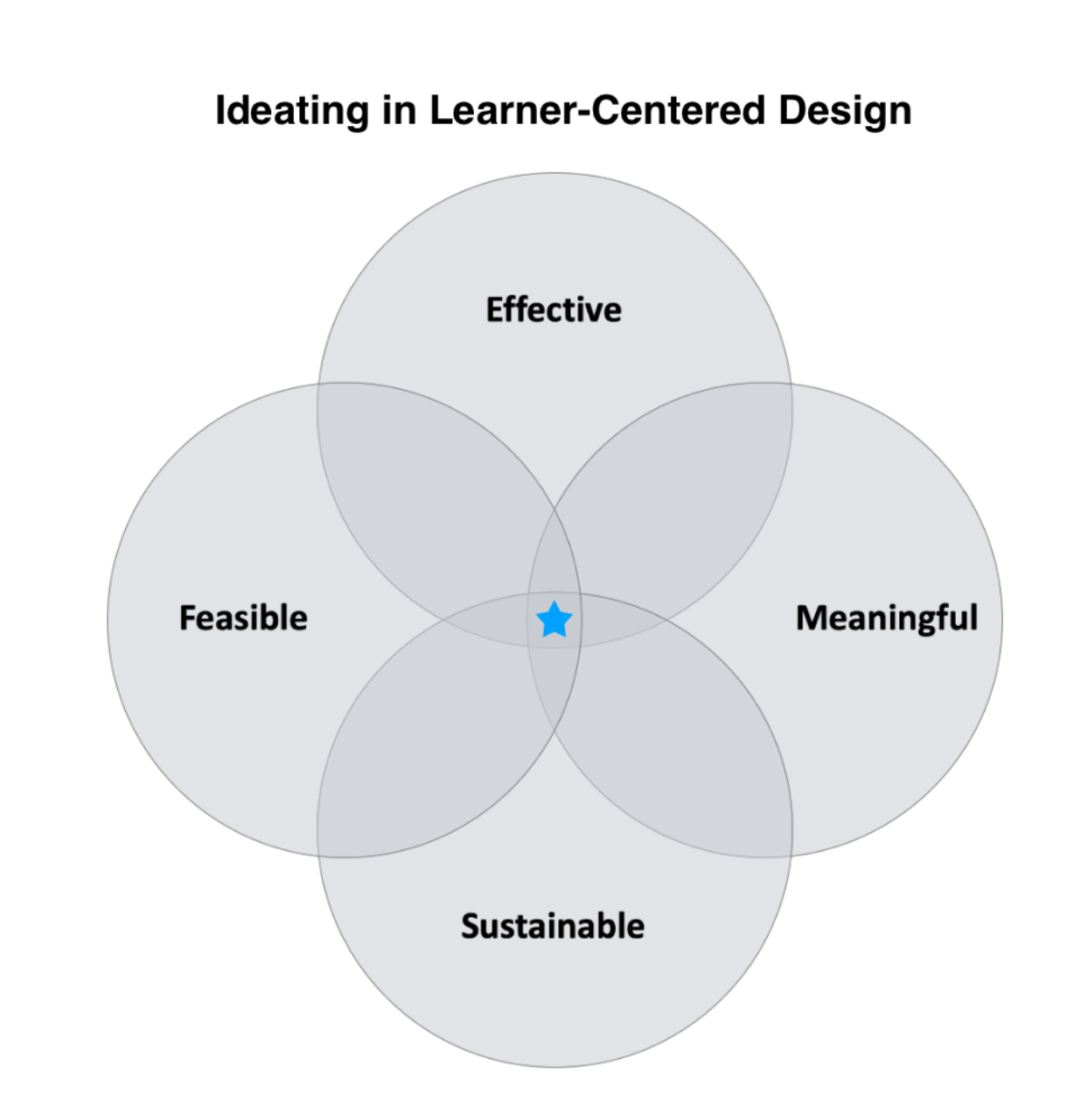
Figure 10. Ideating in learner-centered design involves working toward effective, meaningful, feasible, and sustainable ideas.
Universal Design for Learning
Universal Design for Learning (UDL) is a way of thinking about teaching and designing learning experiences so that all students, of varying abilities and talents, have equal opportunity to learn (CAST, 2019). Universal design is not the same as accessibility (discussed later in this chapter). Whereas accessibility is focused on ensuring access, universal design is focused on ensuring opportunities to learn. Accessibility is a prerequisite to UDL.
UDL involves integrating choice and customizability into learning designs in three key areas: (1) how students are stimulated to engage with the learning and with each other, (2) how to present content in different ways so there is choice, and (3) how students are able to express and demonstrate what they know. For example, changing a synchronous discussion into an asynchronous discussion allows students to engage in additional think time, and means they can respond at any time during the day or night. Providing both video and text presentations of content allows those who prefer print (or don’t have the ability to watch a video) to read the content, while others who prefer the sights, sounds, and presence of a video may watch. Allowing students to incorporate their own experiences (a core component of andragogy) and providing choices for how they present their work lets students leverage their skill sets and talents—and enables the instructor to more accurately assess their knowledge in application.
Throughout the mapping and blueprinting process, the three principles of UDL should be kept in mind, as they will support the course’s effectiveness in achieving its outcomes.
Reify and Refine the Specific Solution (Experience) Through Prototyping
To reify an idea is to make it less abstract, or more real. The goal of prototyping anything, whether it is a mobile phone or a module within a learning experience, is to reify that idea to gain insight. Prototyping helps answer some of the following questions (in addition to generating new and sometimes unexpected ones):
- What might it look like?
- Does it work?
- How does it work?
- How can it work? What are other possibilities?
- How does it feel to use it, to be in it?
- Is there anything unexpected?
- Do we need to rethink some ideas?
- Are some of our ideas not feasible?
- Did the prototype lead to more questions?
- Are there ideas or possibilities we didn’t think of before?
- What can we expect?
- What will it look like?
- How can we build or generate better ideas now that we know how it looks/works/feels?
- Can we tweak it to be better?
- Should we scrap our ideas and start again?
Again, in the spirit of rapid prototyping, the goal is to get feedback early and often; as such, designers should prototype as early as possible in the design process. To prototype an idea is to fully build out as much of the learning experience as possible to get a feel for the direction it is heading in, and to test it—for example, building out a module or a portion of an interactive. This also allows the designer to run test learners through a “mini-experience” of the course to gain deeper insight into how it is experienced by learners and what should be changed. (In the design thinking model, this is a small instance of learning and iteration).
There will also be impacts on ideation and blueprinting from the process of prototyping (especially in ill-defined or ill-structured design scenarios). Designers must plan ahead and give themselves time to learn from the prototyping process.
Develop the Final Experience Design
The final learner experience design is the design that learners will actually experience. Often this resides in an LMS, but it can take many different forms. The course may be blended, or it may be a small interactive module. Learning experiences take many shapes.
Development is ideally accomplished by a team. Often an instructional designer and instructional technologist will pair together; there may also be videographers, graphic designers, and sometimes programmers involved if the learning experience is highly technical in nature. In each instance, the final experience will look and feel different. Whatever the final experience, it should be learner-centered (meaningful, pleasurable, effective), achieving the goals and mission stated in interviews and the charters.
Refinement Through Quality Assurance
Throughout the blueprinting and development process, quality reviews should continue; again, in the spirit of rapid prototyping, the goal is to get feedback early and often to guide the way forward. Whether using the QM or the OSCQR rubric, the most important component is obtaining a review that ensures the team is accomplishing what is stated in the charter, interviews, vision, and narrative. That makes for a complex review, but it can be done!
Accessibility
Accessibility, while often addressed later in the development phase, should never be an afterthought. Accessibility ensures that individuals with disabilities have access to the learning materials and are able to equally participate and demonstrate their learning achievements. For individuals with vision impairments, this requires ensuring that the learning experience is optimized for screen readers, supports high contrast, pairs imagery with descriptive text, and allows for enlargement of text and text-readable content. For individuals with hearing impairments, this requires ensuring that all audio of the learning experience is captioned and transcribed, and that other audio elements or synchronous sessions allow for equal participation and demonstration of understanding.
Accessibility, especially given the ever-growing use of technology, requires diligence to ensure equal access, and often requires team effort and collaboration. One quality resource for accessibility is the Quality Matters Accessibility and Usability Resource Site (QM AURS; see Quality Matters, 2018), as it focuses on ensuring that learning is accessible for all.
Fundamental 6: Continually Learn and Improve Through Teaching, Reflection, and Learning Analytics
—Frank A. Clark
The purpose of quality instructional design is not just to design learning for students; it is also done to set instructors up for success in teaching. Exceptional instructional design enables the instructor to focus on facilitation, intervention, and feedback in online and blended settings, whatever the learning framework and instructional strategies used. Quality learner experiences often parallel quality teaching experiences.
Refresh Data Inputs: Experiences and Analytics
Two primary types of data should be collected to iterate designs in a data-driven way: experience data and analytics (see Figure 11).
Learner and Teacher Experience Data
Information about the learner and teacher experiences often comes through continual reflection, notes, conversations, interviews, observations, and surveys. Throughout the teaching process, instructional designers can engage in periodic reflections on the following topics:
- What went well?
- What could be better?
- What can we do differently in the future?
- What should stay the same in the future? (What do we NOT want to change?)
Some reflections can be immediately implemented—for example, giving clearer feedback or refining the wording of future announcements. Other reflections will reveal iterations that must wait for a refresh cycle of the course—ideally, immediately after the course is taught for the first time. If the instructor keeps a reflection log of these questions, asked at the end of each module, this log will serve as a valuable data resource for continual improvement.
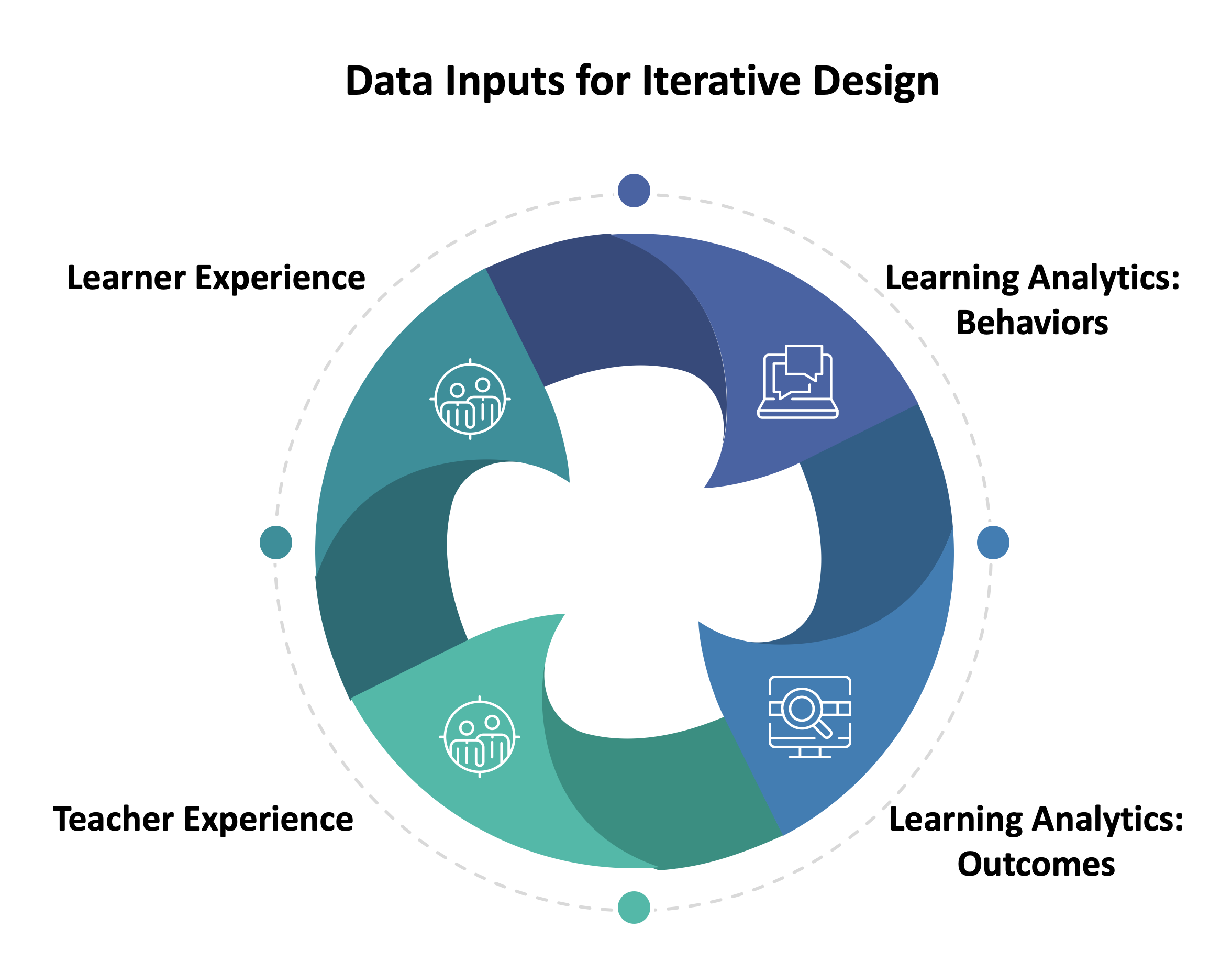
Figure 11. Primary inputs for ideation of continuous improvement in instructional design.
Learning Analytics: Outcomes and Behaviors
Learning analytics is “the measurement, collection, analysis and reporting of data about learners and their contexts, for purposes of understanding and optimizing learning and the environments in which it occurs” (Siemens & Gasevic, 2012). An amazing amount of data is collected that can be used for course iteration, and for the purposes of informing iterations in course designs. Data on performance, engagement, and the degree to which students achieved the outcomes are collected in modern systems (rubric ratings, assessment scores, discussions, sentiment analysis, and group engagement, to name a few). In addition, data on test items and quizzes can also be obtained to continually ensure the validity of both low-stakes and high-stakes test items as well as to flag potential issues in the wording of questions. Continuous improvement uses this information as an input into the discovery stage, and the process begins anew.
Summary
This chapter only scratches the surface of quality instructional design. However, it reviews six fundamentals for exceptional instructional design through mindset and approach:
- Fundamental 1: Make design decisions using the three lenses of learning innovation;
- Fundamental 2: Use design thinking as the “way of thinking”;
- Fundamental 3: Strive for deep empathy and understanding to accurately discover and define context, problems, and goals;
- Fundamental 4: Establish flow through vision, narrative, and learning frameworks;
- Fundamental 5: Iteratively ideate, curate, and develop;
- Fundamental 6: Continually learn and improve through teaching, reflection, and learning analytics.
These fundamentals for mindset and approach, taken together, form a solid foundation for exceptional instructional design.
References
Allen, S. (2012). Leaving Addie for Sam. Association for Talent Development.
Anderson, S.P. (2011). Seductive interaction design. New Riders.
Arnold, J. (2016). Creative engineering: Promoting innovation by thinking differently. Maslow: University of Texas Press.
Biggs, J. B., & Collis, K. F. (2014). Evaluating the Quality of Learning: The SOLO Taxonomy (Structure of the Observed Learning Outcome). Academic Press.
Carmack, J. (2019). “#1342, John Carmack.” The Joe Rogan experience. Retrieved from https://podcastnotes.org/2019/08/29/carmack/
Center for Applied Special Technology (CAST). (2019). “About Universal Design for Learning.” CAST. Retrieved from http://www.cast.org/our-work/about-udl.html
Clark, Don. 2015. “ADDIE.” Big dog and little dog’s performance juxtaposition. Retrieved from http://www.nwlink.com/~donclark/history_isd/addie.html
Dick, W., Carey, L., & Carey, J. O. (2014). The systematic design of instruction (8th ed.). Pearson Education.
Gagné, R. M. (1965). The conditions of learning. New York: Holt Rinehart & Winston.
Gibbons, S. (2018). “Empathy mapping: The first step in design thinking.” Nielsen Norman Group. Retrieved from https://www.nngroup.com/articles/empathy-mapping/
iDesignEDU. (2019). “Instructional approaches.” In iDesign iDEA book. iDesignEDU. Retrieved from https://drive.google.com/file/d/1j3TALoQRFTENCL7Iy2KchbKjWo1BiuU1/view
Interaction Design Foundation. (2019). “Design thinking.” Retrieved from https://www.interaction-design.org/literature/topics/design-thinking
Keller, J. M. (2010). Motivational design for learning and performance: The ARCS model approach. New York: Springer.
Kelley, T. and Kelley, D. (2013). Creative confidence: Unleashing the creative potential within us all. New York: Crown Business.
Kilgore, W. (2016). UX to LX: The rise of learner experience design. EdSurge. Retrieved from https://www.edsurge.com/news/2016-06-20-ux-to-lx-the-rise-of-learner-experience-design
Maslow, A. H. (1943). A theory of human motivation. Psychological Review, 50(4), 370–396.
Maslow, A. H. (1954). Motivation and personality. New York: Harper and Row.
Merrill, M. D. (2002). First principles of instruction. Educational Technology, Research and Development, 50(3), 43–59.
Miller, G. E. (1990). The assessment of clinical skills/competence/performance. Academic Medicine: Journal of the Association of American Medical Colleges, 65(9 Suppl), S63–S67. https://doi.org/10.1097/00001888-199009000-00045
Quality Matters. Quality Matters Higher Education Rubric (6th ed.) Retrieved from https://www.qualitymatters.org/sites/default/files/PDFs/StandardsfromtheQMHigherEducationRubric.pdf
Quality Matters. (2018). “Address accessibility challenges with AURS.” Retrieved from https://www.qualitymatters.org/qa-resources/resource-center/articles-resources/accessibility-resource-site
Siemens, G., & Gasevic, D. (2012). Guest editorial-learning and knowledge analytics. Journal of Educational Technology & Society, 15(3), 1–2.
Simon, H. (1969). The sciences of the artificial. The MIT Press, Cambridge, MA 1969.
SUNY OSCQR. Rubric. Retrieved November 9, 2019 from https://oscqr.org/
Webb, N. L. (2002). Depth-of-knowledge levels for four content areas. Language Arts, 28(March).
Wiggins, G., & McTighe, J. (2011). The understanding by design guide to creating high-quality units. Alexandria, VA: ASCD.
Vygotsky, L. S. (1978). Mind in society: The development of higher psychological processes. Cambridge, MA: Harvard University Press.
